September 13th, 2009 · 4 Comments
My trip to the British Museum was determined by one goal, to see the Parthenon Gallery and then move onto the rest of the Ancient World exhibitions. This goal formed during my junior year of high school when I was taking an AP Art History course. When we began the section on Greek Art and Architecture a main point of our discussion sessions focused on the British Museum’s collections, particularly the Parthenon Collection. I remember vividly the heated debates we had concerning the right of the British Museum to keep the statues taken from the Parthenon. My teacher’s advice on the subject though was to withhold on our final judgment until we could actually view the Parthenon Gallery at the British Museum. So this had me more than just a bit excited to see this exhibition and what else the museum had to offer.
As I entered the Parthenon Gallery, I was struck by the beauty of the friezes, metopes and pediments. The way they are arranged is to show them as they would have appeared on the Parthenon. The metopes and friezes are organized into their appropriate sections and the pieces placed in their original order. It is a unique opportunity to see temple friezes, metopes and pediments from the ground as they were meant to be seen. Yet there is equal beauty in being able to walk along these elements of an ancient temple and being able to view their details at eye level. This exhibition is simple in how it presents the sculptures, but it is the most effective way for the viewers to appreciate the beauty of the Parthenon sculptures. I found myself very appreciative of the gallery and was able to look past the controversy concerning the rights of the British Museum to the ownership of the sculptures.
The question that the museum poses in the pamphlet it printed in response to the controversy is one of not ownership but one concerning the protection and display of the sculptures. It states that the Parthenon was being destroyed at the time when the sculptures were taken by Lord Elgin. It was for preservation of the sculptures that they remained with the British Museum. Moreover, they are part of a collection on the Ancient World, which Greece and the Parthenon were very much part of. So it seems to me, that these sculptures are preserved, protected and appropriately displayed within the British Museum. It is only this preservation, protection, and respectful presentation that persuades people to support the British Museum’s right to keep the statues. Also, there are sculptures from the Parthenon in Greece, at the new Acropolis Museum. If there were no sculptures left to preserve and present in Greece, then my opinion would be different, but since there is preservation and appropriate presentation of them here in London it seems better for them to remain.
Tags: Kimberly
September 2nd, 2009 · 3 Comments
One thing that I have been noticing a lot about London is the accessibility and services available for people who are disabled or handicapped in some way. Much like what you would tend to expect from American cities, there are handicap accessible entrances, ramps, elevators, and automatic doors leading to many of the major museums and tourist attractions around London. However, I have observed less-than-wonderful wheelchair-friendly services in the Tube stations.
Looking at the Underground map, there are only 9 stations within Zone 1 that have step-free access from the platforms to the outside world. Now, I grant that the map shows that the bigger stations or those with rail stations attached tend to have wheelchair accessible facilities, but there are still a number of problems. First, there’s the gap to mind, which while it is not beneficial to the elderly or buggy-pushers, seems to be a very large potential problem for people in wheelchairs and using crutches to get over. Secondly, with the current construction projects occurring at many of the major Tube stations, some facilities that would normally be easier to maneuver around are currently out of order. The only saving grace of the transport system for those movement-impaired seems to be the bus system. From what I have noticed of the buses, the majority of them are fitted with a hydraulic system that either allows the bus to be lowered curbside or a platform for a wheelchair.
Despite my criticisms of the Tube as a vehicle of transport for people in wheelchairs, London has managed to greatly surprise me in the leaps-and-bounds of services for other handicapped peoples. When I was at the British Museum the other day, I noticed a sign that mentioned that there is a Touch Tour for people who are blind or visually impaired. I’ve never encountered anything like this before, but think that it is a brilliant idea! This tour allows them to touch specific objects in certain sections of the Museum in order to get an idea of what the art from that culture “looks” like. Accompanying these objects were plaques in Braille explaining the object they were “looking” at.
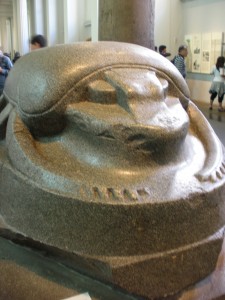
Scarab from the Egyptian section of the Museum - on the Touch TourSign for the Blind Touch Tour
I was struck again by the services provided for disabled/hard-of-hearing peoples tonight at the performance of All’s Well That Ends Well at the National Theatre. One of the last things I was expecting when I entered the theatre was to have a closed captioning screen for the play! Despite this service being aimed at those deaf/hard-of-hearing people, I benefited greatly from being able to see some of the dialogue I missed either by zoning out or simply not being able to hear. Although I did find the screens slightly distracting at times, I think that it was a brilliant idea that should be implemented at many more theatres in the world.
Overall, I am finding London to be a very mixed city of accessibility and services for people who are disabled or handicapped in some way. I think that the Tube stations need some work, but as construction is constantly being done on them, I know that they will be improved upon eventually. On the other hand, I think that the Touch Tour and the closed captioning in the theatre were both wonderful ideas that should be implemented in the States and around the world if they haven’t already. Any thoughts or observations on services and accessibility?
Tags: Kelley · Museums · Theatre
Hey there, Patsy and Amanda Girl here, your one and only source into the the scandalous lives of Londons elite,
(aka Dickinson college Norwich Humanities students)
In the last few days we have made quite the dent in our list of required activities. Instead of blogging after each trip, we decided to collaborate our ideas and opinions within in one “museum” post.
At this particular time we have gone to both the British Museum and the Cabinet War Rooms/ Churchill Museum. What we would like to do, is continue to add information about required museums to this post during the remainder of our time in London.
Although Amanda cheated and already wrote about the British Museum, we will further our analysis of this great house of stolen goods in this post. After a morning of strolling over eroding bodies, we found a glorious pizza joint and indulged ourselves with BBQ chicken pizza and a meaty calzone. Realizing we ate our body weight in food, we decided to return the Bloomsburry area to change for the gym. Needless to say our intentions were not strictly academic so, to get back on track, we agreed to visit the British Museum before our workout.
Our first impressions of the museum held true to Professor Qualls’s notion that to see everything would take a full day. After searching for a map, we began our search through the main level. In order to refrain from repeating what everyone has already written about this museum we have decided to note only our specific interests. We found that our two favorite exhibits were the table displaying rows and rows of pills, and the Greek Parthenon. Our initial thought was that the British were very lucky to have such precious and historical artifacts for any average person to view. However, after walking through each room, we realized that a such an extensive collection, from all over the world did in fact represent how powerful the British empire was. Are we ones to judge how these artifacts came into the possession of Britian ? We don’t think so, but it is fascinating to attempt to understand England’s direct relationship with countless foreign countries.
This is a perfect transition to our visit to the Cabinet War Rooms and the Churchill Museum. Before we entered the museum, we happened to stumble upon the traditional changing of the guards ceremony. Lets just say we became mildly afraid of fancy uniforms, big horses, and yelling. After our wild encounter with the guards, and a few stops to admire our surroundings, we walked over to the museum. We paid our admission fee and began our journey through this underground world. We were very impressed by the museums state, and became intrigued by the history of the Blitz, (luckily the next day we were informed by our class in Regent Park). We came to an exit, feeling mildly unimpressed with how short it was, and then realized we hadn’t seen the Churchill Museum. We then ventured upstream back to the museum.
The Churchill Museum is exactly that, a memorial museum to Winston Churchill that, depending on you attention span, can captivate you for quite a while. We both agreed that the overall construction of the museum was one of its most appealing characteristics. Its shape, lighting, and interactive activities provide entertainment for a wide age range. We were most amused by the time line in the center of the room that, when touched, displayed data from days of Churchill’s life.
Although these two museums, for the most part, have absolutely nothing in common, they both demonstrate critical and influential aspects of British history. Each museum we visit solidifies the idea that Britain is always evolving. Not only its people, but its ideas as beliefs as well.
By the way, the Gym down the street, Oasis, is not a gym! We were dressed and ready but it was nothing. Disappointed?
Some things never change, London better love us.
xoxo
Patsy and Amanda Girl
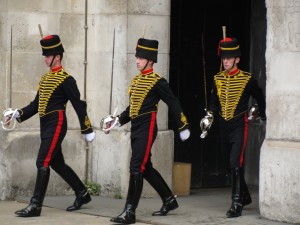
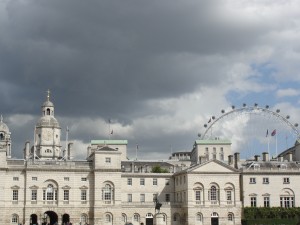
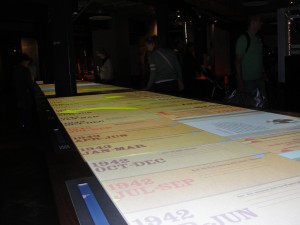
Tags: Amanda · Patsy
August 31st, 2009 · 1 Comment
Anyone who has had a class with Professor Maggidis will know the Greek side of the Elgin Marble story quite well. According to him, the elaborate carvings were forcifully taken from the sides of the Parthenon by Lord Elgin, who did not have a right to them. The British Museum told a very different story. The current position of the Museum is that the Marbles were removed legally with the permission of the Ottoman authorities. However, the Greeks were not asked their opinion. Since the early 1980s, the Greek government has argued for the return of the Marbles to Athens. The British Museum believes that they are “a unique resource for the world: the breadth and depth of its collection allows the world to re-examine cultural identities and explore the complex network of interconnected world cultures.” This same mission statement also applies to the other artifacts of the Museum. However, “the Trustees’ view [the Elgin Marbles] are part of everyone’s shared heritage and transcend cultural boundaries.” To them, the splitting of the Parthenon Marbles between six major museums of the world allow for different interpretations to be examined. We are not so sure. What gives the British Museum the right to possess the sculptures after the Ottoman Empire dissolved and the Greek government asked for them back? Would they appreciate capstones from Stonehenge appearing in the Louvre or another major art museum of the world? Where’s the line between exhibiting cultural artifacts and claiming them as your own? You might ask us if we benefited from seeing the Elgin Marbles for free in the British Museum. Of course we did.
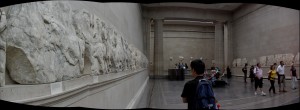
The Elgin Marbles in the British Museum - should they be here?
Continuing on our critical journey through the British Museum, we were struck by the assumption that every culture that the British encountered became part of the British cultural heritage. This was especially apparent in parts of the former Empire. This attitude was even expressed in places that dissolved from the Empire centuries ago. For example, after Buffalo Bill’s Wild West show in London, Queen Victoria was talking to Black Elk (a Native American chieftain) and said “I wish that I had owned you people, for I would not carry you round as beasts to show the people.” Although Queen Victoria probably meant well, this statement is preposterous! We think she meant that she didn’t approve of the Native Americans parading around making a parody of their culture for the entertainment of others. However, there seems to be a discrepency when looking at the colonies under Victoria’s control (India, Hong Kong, Africa, etc.).
The British Museum has made us rethink who should have posession over a cultural artifact. We believe that it’s a major grey area. Does a British archeologist digging in France have the right to the objects found, or does the French government? There are too many variables. We enjoyed almost everything we saw at the Museum and it was a great learning experience, but we couldn’t help but feel an uneasy sense of awe in the rooms where the decoration was in Britain, but the structure was elsewhere in the world.
Tags: Bureucracy · Grace · Kelley · Museums
-
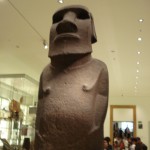
-
Part of the African Exhibit in the British Museum
-

-
Hyde Park Waterfront
-
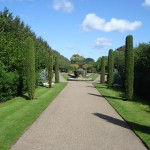
-
Regents Park
-
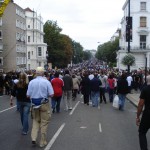
-
Walking towards the Notting Hill Carnival
-
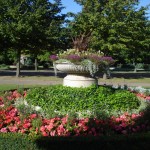
-
Flowers in Regents Park
-
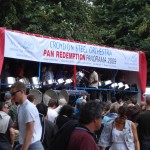
-
Steel Drum Ensemble in Hyde Park
After a busy few days nothing could be more relaxing than a day spent in a park…well two actually. In the morning we started out the day with a class in beautiful Regent’s Park located just a few minutes away from the Arran House. Our classroom discussion centered on two very different topics; Virginia Woolf’s Mrs. Dalloway and “the Blitz”. Despite the difference in subject material both conversations brought up some interesting points and I found myself seeing new perspectives on a lot of things both from my peers and from Professor Qualls.
Maybe it was just the time of day (early on a Saturday morning) but Regent’s Park had a very quiet, quaint feel to it. I realize there is still much of the park that I need to explore but from what I saw with the beautiful flower gardens and shrubbery and wide pathways it seems like it would be a great place to go for a run or relax with a book.
After a great lunch at an affordable mediterranean sandwich place with the three Andrew’s I headed out with Alli, Sarah, Mara and Kim to continue the preliminary work for our group project. We headed to Hyde Park, a place we knew would occupy most of our afternoon. Hyde Park immediately reminded me of Central Park more than any other green space I had visited in London thus far. We decided to wander towards the long expanse of water known as “the serpentine” running through the middle of the park. Along the way we passed a large group of people playing steel drums and moving to the music. The park felt alive and it was the first green space that I felt like was being utilized for large group purposes.
The water was filled with waterfowl of all shapes and sizes. There were ducks, swans and geese just to name a few. We saw that there were opportunities to rent boats for seven quid and we thought it would be a great idea to come back and do that another time. After crossing a bridge we came upon a Peter Pan statue. This was a perfect group photo op. After sitting down and taking in the scenery for a bit we headed back to the park exit content with our decision to choose Hyde as the basis for our group’s walking tour.
Sunday was another busy day. Aidan, Brandon and I headed to the British Museum where we attempted to get through the whole thing. This did not happen. We did end up getting through the Middle East, Greek, Roman, African and North American exhibits however. All in all not bad for one day. We also viewed a special exhibit the museum was featuring about living and dying. This certainly defied the plain yet effective pattern the British Museum has going for it. In one section of this exhibit there was a woman and a man featured. There was a long tapestry made out of all of the pills these two people took throughout their lifetime. Everything from vitamins to birth control to painkillers for arthritis were featured in this amazing display. There was also a display done on how different cultures around the world react to life and death and even how they bury their dead. Not only was this a fascinating exhibit but it added a whole new wrinkle to the British Museum.
After a quick break Brandon, Aidan and I decided it would be interesting to head over to Notting Hill where the annual Notting Hill Carnival was taking place. We had been warned multiple times to bring only the bare minimum and be extremely careful with our belongings. We had also been warned about the huge crowds and lack of personal space we would encounter. Unfortunately for us nothing could have prepared us for what we saw once we got off of the Notting Hill tube stop. Endless masses of humanity were walking. We had no idea where their final destination was so we simply followed. Eventually the street opened up and even more people appeared. There were floats making their way down the streets, loud music blasting and people dancing and singing. It was unlike anything I had ever seen before. People that lived in the area were charging others money to use their bathroom. There were no trash cans so litter was piling up in the streets. Other folks were walking around with coolers of beer and soda in an attempt to make a little money. Although large crowds are not my thing and I do enjoy my personal space going to the carnival was an eye opening experience. As Americans sometimes we are so driven to achieve a certain goal, meet a certain deadline, fulfill a certain quota. There has to be some sort of end reward for everything. The nice thing about the Carnival and the thing that I struggled to understand the most is that there was really no point to it. Each and every person made their experience what they wanted it to be. Some used it to express their cultural heritage, some used it as an excuse to hang out with friends or family and some simply used it to get drunk. The bottom line was that everyone was there and having a good time in their own right.
After navigating our way through masses of people we veered off the main path a little bit and found a street with some places that looked like they would be good to eat at. After completing our meals we decided we should start finding a way out of the carnival knowing that it would take us a very long time to navigate out of the crowd. For a while it seemed that no matter where we walked there were people in every direction with no apparent end in sight. Finally we approached a street corner and across the street there was traffic, the first sign that the festival had an end. We attempted to navigate our way to Paddington Station but after a decent walk opted to take the bus to Great Portland Street instead and walked back from there. The entire journey took less time than I thought it would and we were back at the Arran House by a little after 6.
As I continue to explore here I feel like I am getting a better sense of all the different expressions London has to offer. I’ve seen it’s artsy side, it’s serious side, it’s fun side and it’s theatrical side. What will I find next?
Tags: Henry · Museums
August 30th, 2009 · 1 Comment
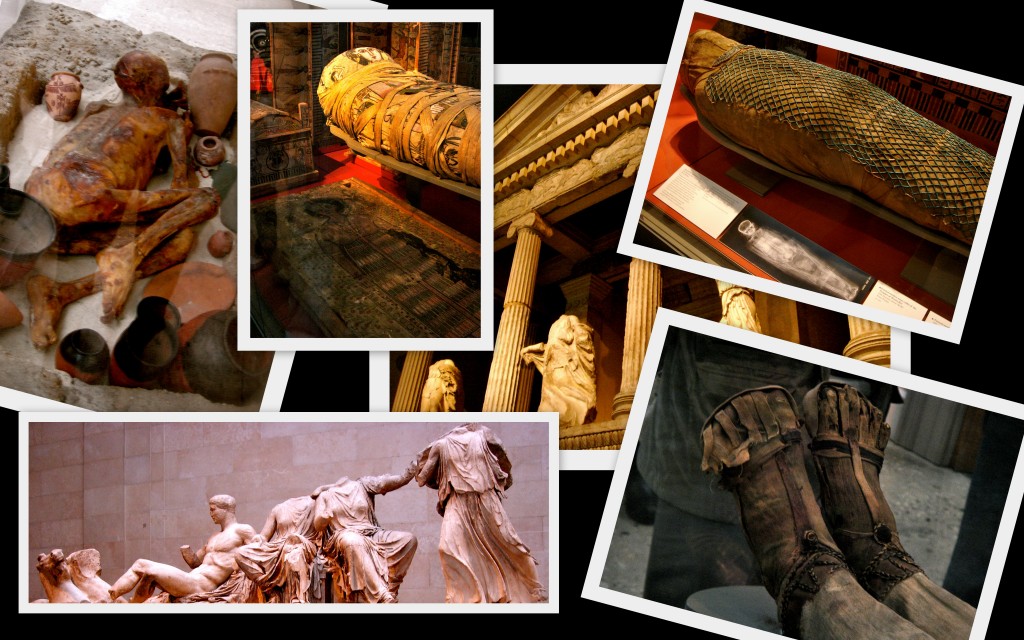
[Author’s note: I am a lover of museums, I enjoy the idea of presenting something for public admiration, yet the following post is a type of critique directed towards museum culture. The questions I pose seek responses and if you can and are willing to I am more than happy to receive responses and to discuss comments and ideas.]
Every civilization constructs themselves in unique ways, develops rituals, cultural symbolisms and folklore depending on the values, morals and believes of either a powerful minority or the general population. When I visited the British Museum today I was at awe at the number of Egyptian objects on display and could not help but to inquire about their present state. I know this is a museum and the point is to display objects of interest to the general public, after all that is how revenue is made and popularity is obtained, the “weirder” the object the more people that want to come see, but why? I realized that museums practice a form of cultural fragmentation, they present to the audience a piece of a culture/civilization, the one that we (as the audience) will be most intrigued by; again, but why? why are we always fascinated with that which is different from the things that we know (as “normal”)? What makes us so superior that we have taken the right to place other cultures on display as if they were commodities? Thousands of years displayed in one room, objects preserved for a lifetime and …mummies on display? Whatever happened to resting in peace?
If Egyptians believed in placing specific objects in the tombs of their pharaohs for the after life then guess what, we have totally screwed up thousands of years of ritualized mummification for the sake of cultural representation. For as silly as this may sound I was a bit saddened to realize that if Cleopatra came back in her after life she would have no wealth, it has been divided among different museums and collectors all overt eh world. Her mummy was assigned a resting place, a burial ground, for a reason, and by removing her from that environment we have damaged the fabric of one of the world’s most intricate civilizations. How dare we disrupt the living dead? How dare we destroy sanctuaries, transport them across the globe, and study them as if they were meant to be objectified in the first place.
Although, I was extremely impressed at the sculptures of the Parthenon (located at the exhibit on Greece at the British museum), once again I asked myself: Why are these magnificent structures here? Why are they not at the Parthenon where they belong? Later in the day I learned from on of my classmates that it’s a complicated history which most of us know nothing of. She explained to me how parts of the Parthenon were being stolen from their original site, and so someone “rescued” pieces in order to preserve what was left of it (these are some of the pieces on display). Ok, just maybe some of the objects displayed are righteously justified, but my questions still stand: why are we always fascinated with that which is different from the things that we know (as “normal”)? What makes us so superior that we have taken the right to place other cultures on display for our own leisure?
The questions rumbling through my mind make me think back on my Workshop in Cultural Analysis class last semester (at Dickinson) where we discussed issues with cultural representation, fragmentation, fetishism, commodity culture, among others. In this class I wrote a paper in which I argued that much of the discourse we know as “truth” (regarding the representation of different cultures) is based on the believes of a powerful minority. In the words of Bell Hooks (author of “Teaching to Transgress” and “Ain’t I a woman,” among others):
Within commodity culture, ethnicity becomes spice, seasoning that can liven up the dull dish that is mainstream white culture. Cultural taboos around sexuality and desire are transgressed and made explicit as the media bombards folks with a message of difference… bringing to the surface all those “nasty” unconscious fantasies and longings about contact with the Other embedded in the secret (not so secret) deep structure … In many ways it is a contemporary revival of interest in the “primitive.”
Even though the quote above speaks better to a more sexualized commodification and/or fragmentation of cultures it is relevant in multiple other ways. As a superpower Britain (as well as the US) have been the “main dish” seeking “spice” to “liven [themselves] up.” Both predominantly “white” civilizations (UK and US) have sought to explore and display the “other” in order to maintain themselves as the “us.”
The questions remain, why display mummies when they were not meant to be exhibited (all over the globe) in the first place?Why do we commodify other cultures, fragmentize them and appraise only a part of them (the part that has been given to us)? Again, every civilization constructs themselves in unique ways, develops rituals, cultural symbolisms and folklore depending on the values, morals and believes of either a powerful minority or the general population. What are we constructing that will be on display a thousand years from now? Would you like to see the complexities of your life minimized to a single cardboard wall (or a short movie clip), on some museum, set up for judgement? Would you like your body to be preserved, put up for auction, displayed on a gallery without your consent? Think about it, how would Cleopatra feel if she was to rise from the dead to tomorrow to find herself in a glass box, on a different continent, far from anything know, separated from her wealth and objects provided to her inside her tomb upon her death?
“A culture is made– or destroyed– by its articulate voices” (Ayn Rand, Russian born American writer and novelist).
Tags: Flow · Uncategorized
This was initially a comment on Audrey’s wall, but I realized I hadn’t written my own blog post yet, and (more importantly) I was getting a bit preachy. So here it is:
I would first like to say that a city devoted to capitalistic endeavors is a beautiful thing. I look around and everywhere I see touristy traps– places trying to make you pay for restaurant seats and churches. Bath was no different, save for its own self recognition. It didn’t try to be anything it wasn’t. You want to drink our fancy water, you bet your ass you’re paying money. So hats off to you Bath and your unashamed stance, don’t ever apologize!
I, like Audrey and fellow travelers, tried to find the quintessential “Bath.” Far beyond the wrenching grasp of the tourist industry. I wasn’t looking for anything beautiful though, on the contrary. I attempted to walk to streets further into the realm of residential. I found parks with no names, pubs with local patrons drinking at 2 in the afternoon, and shady alleyways with no pretty walls or paintings of any kinds. It was no landscape shot, but there was a beauty in the simplicity. Sadly, I had no idea how to get home and wondered aimlessly for quite a while until like a beacon of hope I ran into Professor Qualls, who told me I was only a turn away from the church (I swear I had been wondering for a long time).
My love of Celtic heritage made going to Stonehenge cool. I mean the curiosity of the whole thing was pretty cool, especially seeing how the English lady on the head set phrased their speculation on its purpose. Honestly, I thought they weren’t very culturally relative: they kept applying a few modern ideas to the potential purpose. The thought that Stonehenge would be a symbol of power with other purpose seems a bit silly. Further, they kept bringing up concepts of hierarchy, which is complete speculation. Anyway
Next big thing was Borough Market, which was incredible. I have found my new love, sorry Planet Organic. How busy and hectic it was. The mushroom dip was especially delicious. Anything from Kangaroo burgers to a bottle of red wine can be found there.
I can’t exactly remember chronological order, but we saw Troilus and Cressida at the Globe Theatre, and I was quite happy with it. I felt they leaned a little too hard on the comedy side, but I was in a strange mood when I read the play initially. All the actors were fantastic and the visual aspects of the people were quite engaging. It is always interesting to read works based around the Trojan War. I remember when I was but a wee-lad, and my grandmother read the Illiad to me, thinking how amazing Achilles was and not really caring about Hector too much, but as I matured and read the work again by myself I began to sympathize more and more with him and less so with Achilles, which I think is the idea. Both warriors are bound by a sense of honor and fate. After watching this preformance, I felt that Hector was almost more enslaved to his sense of duty than Achilles was to his pride.
The British Museum was pretty cool, and I think I finally get what everyone else has been feeling. When I was at the National Art Gallery, Paul stopped me to point out Sunflowers, by Van Gough, and I wasn’t really sure what to say. Cool? But when I was at the British Museum, I came across something called the Dancing Shiva (http://dustysojourner.files.wordpress.com/2009/06/shiva_nataraja_musee_guimet_25971.jpg). Last semester I had been one tequilla shot away from having the thing on my back (which doesn’t always mean it has any value to one at all but in this case it did). I’m not sure why, but it’s a symbol I have always connected with. The Nataraja is meant to represent the destruction of the universe through Shiva’s crazy dance moves, but it is also meant to show the oneness of the universe. So there I was, standing in front of this bronze statue feeling as giddy as a little school girl, awesome.
The Cabinet War Rooms and the Churchill Museum. What to say? The Brits love their Churchill. One of the first lines in the head set was something along the lines of Hitler and Churchill both had a cabinet, but Churchill never overroad his. Why bring Hitler into this? The other thing that made me chuckle was when they were retelling the story about the hole punch. Churchill basically chews out this secretary because he uses weird words and she couldn’t figure out what he meant, and then the head set said: but he had a lot of pressure, so it’s ok. Not ok Churchill, not okay. Overall, the museum was a giant pat on the back for the Brits and their ability to live in small rooms for a long time. Seeing where they lived was neat, but it wasn’t incredibly informative and despite having creepy wax figures and listening to recordings, I never felt enveloped in the way, I think, they wanted to make the guests feel.
As a note, make sure you ask the ticket guy for a receipt because they don’t give you one otherwise, and there is no way to be refunded without it– your ticket isn’t enough, and the museum isn’t worth the ten quid.
Anyway, cheers
Tags: Andrew R

St. Martin in the Fields
I’ll start by saying what a thrill it was to go to St. Martin
in the Fields today. As a classical music fan, I’ve long admired the recordings of Sir Neville Marriner and the Academy of St. Martin in the fields. 18 Handel_ Water Music Suite #1 In F Hopefully, that is the Air from the Water Music Suite #1 in F by Handel, recorded at St. Martin in the Fields. I enjoyed the trio today, but especially relished the chance to take in the space where the Academy plays.
On another note, I’ve enjoyed (despite being overwhelmed by) both the British Museum and the National Gallery in the last two days. Even though Henry and I only got to see the Egyptian statues before the British Museum closed yesterday, we were in awe of the sheer scope and grandeur of the place. We had a similar feeling at the National Gallery today.
This leads me to the chief irony of both of these museums, namely that neither is all that ostensibly British. The British museum has a section for nearly every part of the world, while the National Gallery is dependent mainly on work by mainland European artists. What makes these museums British then? I’ve been slowly coming to the conclusion that Britain (both in the empire era and even today) has thought itself something of an arbiter of all world culture. Our Burton reading yesterday mentioned that the visitors from India in the 19th century approved of the British Museum’s India section, all but saying one need not go to India but rather London to understand Indian culture. Similarly, today I saw French and Italian tourists in London today admiring Pissaro and Titian at the National Gallery.
This British “arbiter of all world culture” role, if it indeed does exist, is a very powerful role that is potentially also very problematic. Certainly it is convenient for a traveler or student to have all of this in one city. However, some time ago, I heard about a nation (I believe it was Egypt) demanding a few of its artifacts back from the British Museum. Besides being a tricky legal issue, I feel this says a lot about the power dynamic between Britain and the rest of the world which has come about both as a result of colonialism and the powerful role Britain has had in relation to most of the world since WWII. For some reason it just seems natural and unproblematic to us in the west that the Rosetta Stone should be permanently in London, because we perhaps have subconsciously come to believe that the British have a natural right to something with such value to civilization, without thinking critically about who actually created and contributed to that artifact.

Thoughts on this “arbiter” theory or what it could mean (presuming its reasonable)?
Tags: Aidan
Instead of perusing the Portrait Gallery along with everyone else, Sarah, Alli and I decided to chip away at the vast collections of the British Museum a short walk away from the Arran House in Bloomsbury. Because their collection is so vast, we were only able to manage the Egyptian and Southeast Asian exhibits in one afternoon, but so far I think it’s safe to say that the British Museum is my favorite of all that we have seen.
At every turn in this country, I am astounded by the amount of history and the age of buildings, artifacts, and communities on display both in museums and on the city streets, but the Egyptian section of the British Museum takes the cake for being the most impressive and mindblowingly old. As an American, when something is over one hundred years old, I usually find it quite impressive and worthy of special honor and delicate hands. However, many of the Egyptian artifacts at the British Museum are out in the open, which strikes me as almost irresponsible, since “PLEASE DO NOT TOUCH” signs usually don’t stop small children and excited tourists from running their hands all over these ancient hieroglyphs and pharaohstatues. Besides my worries about greasy fingers and eroded stones, however, I believe I have a new-found interest in hieroglyphics and Egyptian culture based on what I saw this afternoon. While I’m usually not a fan of dead things on principle, I particularly liked an exhibit in a glass case of a remarkably well-preserved man, buried and surrounded by various jars of important things he would need in the afterlife. The idea of preparing a dead person for the unknown with worldly goods fascinates me, and seeing the mummies up close and in person is something I don’t think I’ll soon forget.
Even though we didn’t make it to about 75% of the museum today, by glancing at the floor plan, it was immediately obvious that despite the fact this was the British Museum, there was very little having to do with the Brits in the exhibits. There were whole floors and wings dedicated to Ancient Egypt, Ancient Greece, Southeast Asia and Asia, and Africa, and seemingly most other continents and cultures besides Great Britain. The name “the British Museum” is certainly a misnomer, and I hope to find out the origins behind the name. If there had been a feedback section for visitors to leave their comments like there was in the Docklands Museum, I wonder what the patrons would have said. Because the exhibits I saw were not as politically charged as the slavery exhibit at the Docklands Museum, perhaps the comments would be less scathing, but I imagine that many tourists and visitors have arrived at the museum expecting a museum of British history and leaving without getting what they came for (many comments at the Docklands had been about “missing” components of British history and an imbalance of representation of thinkers and innovators).
Perhaps the name of the museum remains the somewhat confusing “British Museum” because of the elusive definition of “British” itself. Since Britain, specifically London, is such a patchwork of histories and cultures and traditions, perhaps making the British Museum focus on everything but the history that went down on this particular piece of land is actually fitting: each culture gets a historical representation in the broad strokes of the various African and Asian and European galleries, and together these collective histories make up the histories of the individuals who make up Britain.
Tags: Chelsea · Museums














